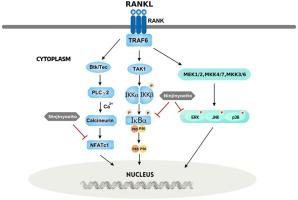中药 Ninjinyoeito 通过调节 NF-kB 和 MAPK 通路,抑制 RANKL 诱导的破骨细胞分化和骨吸收活性。
IF 2.6
Q1 DENTISTRY, ORAL SURGERY & MEDICINE
引用次数: 0
摘要
目的:骨质疏松症是一种全身性骨代谢疾病,以骨量和骨强度下降为特征。破骨细胞(OC)是一种巨大的多核细胞,通过降解骨基质来调节骨平衡。过度的 OC 分化和活动可导致严重的骨代谢紊乱,包括骨质疏松症。目前的治疗方法,包括抗骨质吸收药物,会产生相当大的不良影响,包括颌骨骨坏死。中药,如九节鞭(NYT),也可能具有疗效,但不良反应较少。在这项研究中,我们调查了NYT对破骨细胞生成的影响:方法:采用耐酒石酸磷酸酶(TRAP)染色法和骨吸收测定法研究 NYT 对 OC 分化和功能的影响。研究了OC相关基因在mRNA和蛋白质水平上的表达,以证实NYT对破骨细胞生成的抑制作用。我们还证明了IκBα和丝裂原活化蛋白激酶(MAPK)[细胞外信号调节激酶(ERK)、c-Jun N-末端激酶(JNK)和p38]介导的信号通路的参与,并显示了在破骨细胞生成过程中活化T细胞胞浆核因子1(NFATc1)和核因子卡巴B(NF-κB)p65的核转位:结果:TRAP染色和骨吸收试验证实,NYT能显著抑制OC的分化和功能。Western印迹和RT-PCR结果显示,NYT通过抑制OC相关基因的mRNA和蛋白水平表达,改善了破骨细胞的生成。此外,印迹和免疫细胞化学(ICC)数据表明,NYT抑制了由IκBα和MAPK(ERK、JNK、p38)介导的信号通路,并证明了在OC分化过程中NFATc1和NF-κB p65的核转位:这些研究结果表明,NYT是治疗骨质疏松症的另一种候选疗法。本文章由计算机程序翻译,如有差异,请以英文原文为准。

Herbal medicine Ninjinyoeito inhibits RANKL-induced osteoclast differentiation and bone resorption activity by regulating NF-κB and MAPK pathway
Objectives
Osteoporosis is a systemic bone metabolism disorder characterized by decreased bone mass and strength. Osteoclasts (OCs) are giant multinucleated cells that regulate bone homeostasis by degrading bone matrix. Excessive OC differentiation and activity can lead to serious bone metabolic disorders including osteoporosis. Current treatments, including antiresorptive drugs, exert considerable adverse effects, including jaw osteonecrosis. Herbal medicines, such as Ninjinyoeito (NYT), may also offer efficacy, but with fewer adverse effects. In this study, we investigated NYT's effects on osteoclastogenesis.
Methods
Tartrate-resistant acid phosphatase (TRAP) staining and bone resorption assays were performed to examine NYT's effects on OC differentiation and function. OC-related gene expression at mRNA and protein levels was investigated to confirm NYT's inhibitory action against osteoclastogenesis. We also demonstrated involvement of signaling pathways mediated by IκBα and mitogen-activated protein kinases (MAPK) [extracellular signal-regulated kinase (ERK), c-Jun N-terminal kinase (JNK), and p38] and showed nuclear translocation of nuclear factor of activated T-cell cytoplasmic 1 (NFATc1) and nuclear factor kappa B (NF-κB) p65 during osteoclastogenesis.
Results
TRAP staining and bone resorption assays confirmed that NYT significantly inhibited OC differentiation and function. Western blot and RT-PCR results showed that NYT ameliorated osteoclastogenesis by suppressing mRNA and protein level expression of OC-related genes. Moreover, blots and immunocytochemistry (ICC) data clarified that NYT abrogates signaling pathways mediated by IκBα and MAPK (ERK, JNK, p38), and demonstrated nuclear translocation of NFATc1 and NF-κB p65 during OC differentiation.
Conclusions
These findings suggest NYT is an alternative therapeutic candidate for treating osteoporosis.
求助全文
通过发布文献求助,成功后即可免费获取论文全文。
去求助
来源期刊

Journal of Oral Biosciences
DENTISTRY, ORAL SURGERY & MEDICINE-
CiteScore
4.40
自引率
12.50%
发文量
57
审稿时长
37 days
 求助内容:
求助内容: 应助结果提醒方式:
应助结果提醒方式:


